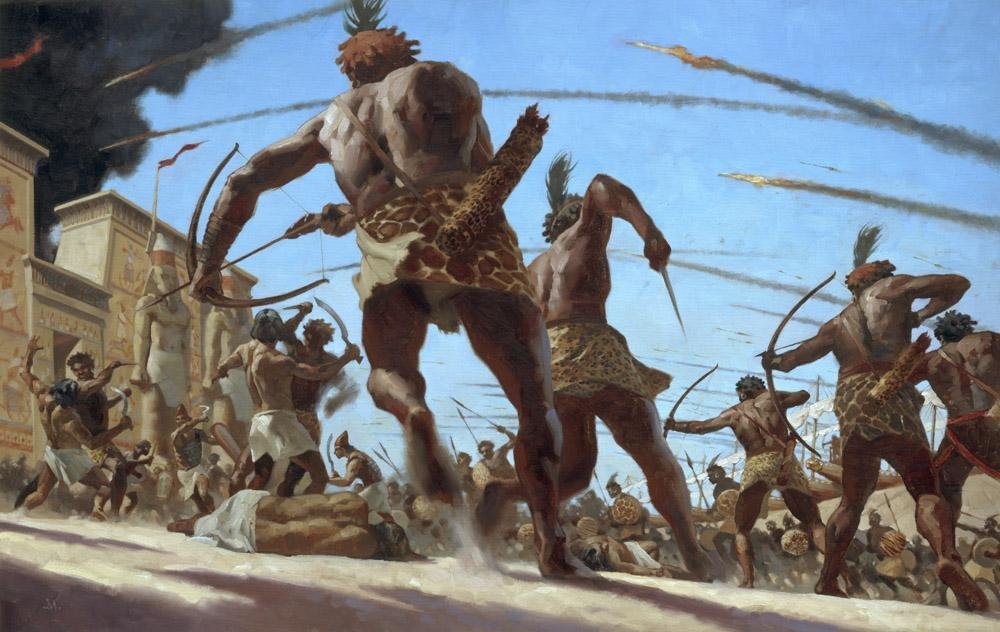Thematic Map (i.e. inaccurate)
Below is a thematic map based on Hyboria, many city names and locations are wrong, as are the names of some regions (no Stygia! Shem and Khem are interchangeable).
 Civilized
Civilized- Khem, ruled by the Pharaoh, though many Nomarchs and High Priests exercise de facto sovereignty in there various dominions. Pa-Nekhen is the seat of the Pharaoh, the Living God, he who shall never die but continuously reborn. Pa-Nekhen is oft referred to by His temple-palace, Karnak. Khem is famed for necromancers and sorcerer-priests, beer, bread, the inundations of the Great River providing great bounty, the scholars of its thousand temples. Bubastsis, city of cats, sits on the clearest channel in the Great Delta and is the main trade city of Khem. Twelve great gods, but each village and district has their own netjer; ennead; gods have skins of gold, bones of silver
- Argos, a land of rivalrous free-cities, though they have been known to ally against outsiders. The Argossi are famed craftsmen and sailors, but not for their sorcerers. The Argossi cities have many different political forms. The nearest Argossi city to Khem is Kyros, a smaller trading hub.
- In the Mountains of Flame (or Fire), is Abaddon, city of the diabolists, graven into the skill-shaped side of a mountain. These slavers prey upon both civilized and barbaric peoples.
Barbarians
- beyond the Mountains of Flame and Plains of Thessalia, dwell the northern barbarians; they fashion iron from the bodies of red dragons, wearing mail and sailing longships, small hill-forts and long halls in river valleys of mountains, vast dark forests
- in the far south, past the Great Desert, lie the kingdoms of the southern barbarians. They are famed bowmen and mighty warriors, hunters of lions.
- seen in civilized lands because offered gold to serve the Pharaoh or Nomarchs, viewed as primitives, but stronger, braver, and less craven than 'civilized' men.
- Northern kingdom names: Koth, Karolan, Middenheim, Nemedia, Brythuin.
- Southern kigndom names: Kush, Darfar, Tombalki.
- the barbarian king Karolus the Great united many petty kingdoms generations ago, instituted worship of the strange One God, now his worshippers war against all who do not worship him. Karolans more likely than most barbarians to fight from horse, screaming as they charge with spears.
Nomads
Nonmen
- travel the desert routes between oases and the Far Roads to the south and east. Many worship Anubis, the Opener of Ways, but consider necromancers apostate.
- excellent at survival in the heat, horse archery, raiding or escorting caravans
Nonmen
- Ophidius, black cyclopean blocks rising from edge of the swampcity state of the serpent-king, ancient sorcerer views mammals as food and experimentation, seek to return to the chaos of Nun,
- lizard folk dwell in the Great Delta, reed rafts, lizard-headed but also crocodilians, newtish skinks, use stone and scavanged weapons; lizardmen keep secret their Sacred Pool where the god Sobek is said to dwell.
- The Favored, animal-headed some say created by sorcerer-priests that bred them, most live in temple precincts, embody attributes of their gods, ignorant folk ascribe semi-divine status to them
- Isles of the Naga, off the coast of Khem, strange sorcerous kings of otherwise arcadian islands
- Desert of Glass (obsidian) rumored in the deep desert
- Desert of Glass (obsidian) rumored in the deep desert

























You have proficiency in the perception skill.
ReplyDeleteLatest jobs in pakistan
Bank jobs in pakistan
job portal in Pakistan
latest private jobs in pakistan
pakistan private jobs
4m brand in pakistan
power brand in pakistan